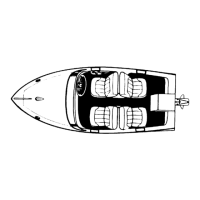90-823225--1 10965E-96 - ELECTRONIC FUEL INJECTION (MULTI-PORT AND THROTTLE BODY)
Code 43: Knock Sensor (KS) (Non-Scan)
(1 of 2)
FUSE 15A
TO SYSTEM
RELAY
KNOCK SENSOR
MODULE
KNOCK SENSOR
SIGNAL
CIRCUIT DESCRIPTION:
The ability to sense engine knock or detonation is ac-
complished with a module that sends a voltage signal
to the ECM. As the knock sensor detects engine
knock, the voltage from the KS module to the ECM
drops, and this signals the ECM to retard timing.
TEST DESCRIPTION:
Number(s) below refer to circled number(s) on the
diagnostic chart.
1. This step ensures that the knock sensor circuitry
is within the proper resistance value.
2. Applying 12 volts with a test light to CKT 496 sim-
ulates a signal from the knock sensor. The knock
sensor is faulty if a response occurs.
3. This step checks if a voltage signal from the KS
module is present at the ECM.
4. This step determines if ignition voltage is avail-
able to power up the KS module.
5. This step confirms the ability of the KS module to
remove the voltage from the signal line when it
sees spark knock. Since the knock sensor pro-
duces an AC voltage signal, it may be necessary
to repeatedly touch the harness connector with
the test light probe to simulate this type of signal.
6. This step checks the ground circuit from the KS
module. If the test light is dim, check ground (CKT
486) for excessive resistance.
DIAGNOSTIC AIDS:
If CKT 496 is routed too close to secondary ignition
wires, the KS module may see the interference as a
knock signal, resulting in false retard.
An intermittent problem may be caused by a poor or
corroded connection, rubbed through wire connec-
tion, a wire that is broken inside the insulation, or a
corroded wire.
Any circuitry that is suspected as causing the inter-
mittent complaint should be thoroughly checked for
backed-out terminals, improper mating, broken
locks, improperly formed or damaged terminals, poor
terminal-to-wiring connections, corroded terminals
and/or wiring, or physical damage to the wiring har-
ness. After repairs, clear codes following “Clearing
Codes” in “ECM Self-Diagnostics.” Failure to do so
may result in codes not properly being cleared.

